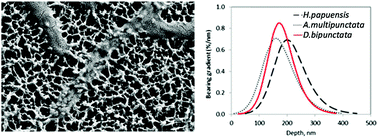The nature of inherent bactericidal activity: insights from the nanotopology of three species of dragonfly†
Abstract
While insect wings are widely recognised as multi-functional, recent work showed that this extends to extensive bactericidal activity brought about by cell deformation and lysis on the wing nanotopology. We now quantitatively show that subtle changes to this topography result in substantial changes in bactericidal activity that are able to span an order of magnitude. Notably, the chemical composition of the lipid nanopillars was seen by XPS and synchrotron FTIR microspectroscopy to be similar across these activity differences. Modelling the interaction between bacterial cells and the wing surface lipids of 3 species of dragonflies, that inhabit similar environments, but with distinctly different behavioural repertoires, provided the relationship between surface structure and antibacterial functionality. In doing so, these principal behavioural patterns correlated with the demands for antimicrobial efficiency dictated by differences in their foraging strategies. This work now reveals a new feature in the design elegance of natural multi-functional surfaces as well providing insights into the bactericidal mechanism underlying inherently antimicrobial materials, while suggesting that nanotopology is related to the evolutionary development of a species through the demands of its behavioural repertoire. The underlying relationship between the processes of wetting, adhesion and capillarity of the lipid nanopillars and bactericidal efficiency suggests new prospects for purely mechano-responsive antibacterial surfaces.


 Please wait while we load your content...
Please wait while we load your content...